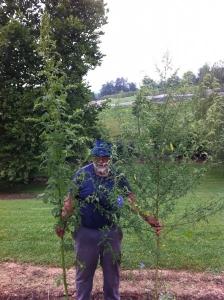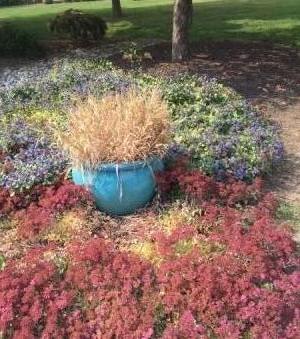
1. Resow grass that is looking a little bare. Look for a good seed mix for your sun/shade conditions. Use the fall rains ( I hope they come soon!) to advantage to germinate and get it established before winter.
2. Get a handle on weeds. Perennial weeds are sending nutrients to their roots for winter dormancy and if you use herbicides, this is an especially effective time to treat. If you don’t, keep pulling. Anything you can do to disrupt the food storage for winter will weaken weeds. Pull annual weeds before they go to seed and deposit to the seed bank in the soil. This will pay dividends in the spring. (See what I did there? Bank, dividends? I crack myself up). Pictured at left is dad with two huge weeds from the garden. Whoops.
3. Divide summer or spring blooming perennials like iris, daylilies, monarda when they have finished blooming. Fall bloomers are best divided in the spring. The daylily bed below our kitchen door is first on the list.
4. Resist temptation and don’t overprune shrubs. Evergreens are best pruned in the spring after their first flush of growth. Fall pruning sends a hormonal signal to send out side branches. New top growth is not what you want going into winter. Prune spring bloomers like lilacs, ninebark or forsythia right after they are done blooming in early summer. They set buds for next spring in the late summer/fall. Late pruning this time of year cuts off next spring’s flowers.
5. REALLY resist temptation and don’t prune butterfly bushes, crape myrtle or other summer bloomers. The last two winters were definitely colder than many in recent memory and gardeners in PA, MD and DE lost butterfly bushes and crape myrtles that had been in the landscape for years. Pruning them in the fall can allow water to get into the crown and crack the trunks over the winter. Rather, prune them in late winter or just as new growth is starting to flush in March/April. For crape myrtles, wait until they’ve leafed out next year to trim back.
6. That being said- do prune crossing branches or sickly limbs to prevent breakage in the inevitable snow and ice of winter.
7. Plant bulbs. September and October are prime bulb planting months. Daffodils, crocus and scilla naturalize readily. Some tulips do as well. We always plant a large bed of tulips at the top of the driveway for spring color, because we never get there with annuals until the spring rush is past. Have fun with some unusual bulbs like fritillaria or giant alliums.
8. Clean up the vegetable bed. Pull out tomatoes, peppers and summer veggies as they finish. A fall crop of kale, lettuce or root veggies like radishes and turnips can easily take their spot.
9. Fall clean-up. Always a debate between those who like to do it in the spring vs fall. Leaving flower heads stand in the fall helps feed the birds, gives winter protection and also spreads a little seed around for next summer. If you don’t want to spend all of June pulling out baby cone flowers, do your clean up in the fall.
10. Mulch or compost leaves. Fallen leaves are a great source of nutrients. Rather than sending them to the dump- feed them back to the ground. Chop them up with the mower, and use them to mulch beds, or start a leaf- compost pile for spring soil amending.
That’s enough to get started!
 1.Ceratostigma plumbaginoides. Easily my favorite Latin name to say out loud. Plumbago or leadwort is a low growing groundcover for sun or partial shade with beautiful bright blue flowers. The foliage also turns a gorgeous hot pinky-purple in the fall. It is definitely a knock-out. Pumbago is very late to wake up in the spring however, so don’t lose hope if you don’t see it right away. (Pictured at left with low growing sedum).
1.Ceratostigma plumbaginoides. Easily my favorite Latin name to say out loud. Plumbago or leadwort is a low growing groundcover for sun or partial shade with beautiful bright blue flowers. The foliage also turns a gorgeous hot pinky-purple in the fall. It is definitely a knock-out. Pumbago is very late to wake up in the spring however, so don’t lose hope if you don’t see it right away. (Pictured at left with low growing sedum). 5.Tricytis- toad lily. The exquisite, speckled flowers resemble small orchids but are much hardier. They grow well in partial sun/shade in moist soil forming spreading clumps. Do site them near walkways or where you can see the flowers up close as they are delicate and not seen well from a distance. They also make good cut flowers lasting at least a week in a vase.
5.Tricytis- toad lily. The exquisite, speckled flowers resemble small orchids but are much hardier. They grow well in partial sun/shade in moist soil forming spreading clumps. Do site them near walkways or where you can see the flowers up close as they are delicate and not seen well from a distance. They also make good cut flowers lasting at least a week in a vase.